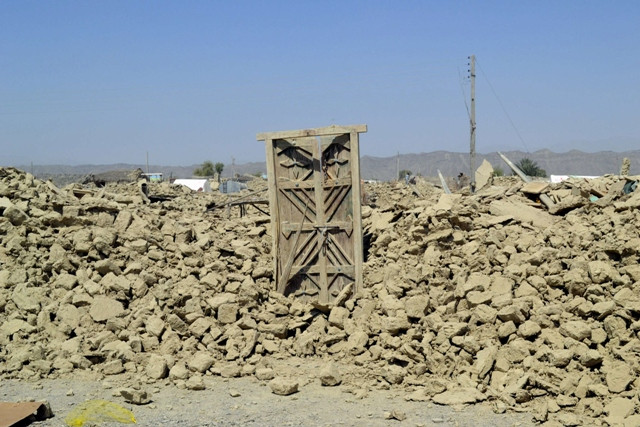The Balochistan earthquake
The armed forces are equipped for ‘first response’ but it will be for the civil administration to do the repair work.

The rubble of a house is seen after it collapsed following the quake in the town of Awaran, southwestern Pakistani province of Baluchistan, September 25, 2013. PHOTO: REUTERS

The September 24 earthquake that occurred in Balochistan, registered 7.7 on the Richter scale (making it more severe than the one that hit Kashmir in 2005) and has killed at least 250 people with another 350 injured — both numbers are expected to rise as aid and relief workers reach the more remote areas. Furthermore, several aftershocks have been recorded, including one that measured 5.9. The area may be thinly populated but where there are concentrations of habitation they are densely packed, often living in fragile mud-brick houses that offer little or no protection in the event of an earthquake. Distances between population centres in Balochistan are long, the roads are indifferently maintained and will anyway have been damaged. Helicopters are being used both to collect evidence of damage and deliver emergency goods to areas that in some cases have been literally flattened. The chief minister of Balochistan has declared an emergency in Awaran, where 80 per cent of houses are reported destroyed, and placed 30 districts of the province on “high alert.” Earthquakes take a long time to recover from in undeveloped regions and previous experience of earthquakes in Pakistan suggests that the recovery phase is bedevilled with inefficiency and corruption, compounding the misery of those affected. Add in the internal unrest in Balochistan and it is easy to posit a scenario that stretches years into the future. There are still people living in temporary shelters as a result of the 2005 earthquake, and it may be another decade before the affected area sees a return to ‘normal’.
There are anecdotal reports of residual anger in the province at the slowness of government response to previous natural disasters and this event must not provide yet another reason for the people of Balochistan to add another black mark to their long list of grievances. That said, it is going to be difficult logistically to get help to the most needy and it is a virtual certainty that there will be people that succumb to their injuries because help did not arrive soon enough. The armed forces are best equipped to provide ‘first response’ but it will be for the civil administration to do the rebuild and repair work — and not just of habitation, as there will be thousands that are physically disabled by the earthquake. Planning for their future needs to begin now, not 10 years down the line. Perhaps if some of the budget given to defence could be directed to strengthening relief and rehabilitation efforts we could have a more adequate civilian response structure in place to deal with such disasters.
The medical and social-sector infrastructure of Balochistan was deficient before this, and will have been locally degraded to the point of extinction in the worst affected areas. Rebuilding schools, hospitals and rural health centres takes time, money and most importantly political motivation. The province is poor to start with and has few infrastructure resources of its own. The federal government of which there were such high hopes, including the still-unfulfilled hope of dialogue with Baloch separatists, appears to be increasingly paralysed by the events that surround it. There is almost as much media interest in the emergence of a small island, a consequence of the earthquake, off the coast near to the port of Gwadar; but what really matters is getting help, and fast, to the poorest and most disadvantaged.
Published in The Express Tribune, September 26th, 2013.
Like Opinion & Editorial on Facebook, follow @ETOpEd on Twitter to receive all updates on all our daily pieces.















COMMENTS
Comments are moderated and generally will be posted if they are on-topic and not abusive.
For more information, please see our Comments FAQ